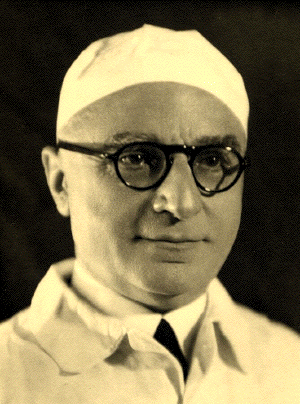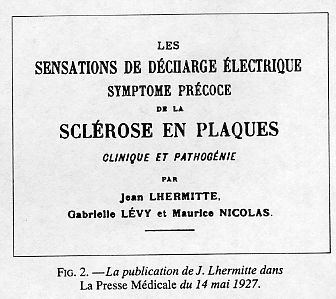- « Le succès consiste
à laisser ceux qui nous écoutent
avec le désir de continuer à nous
écouter
- et non pas avec l'ennui
évident de celui qui en a assez
»
-
 -
- It is always hazardous to state when and
where a discipline was "born". However most
people agree that the discussions held at the
Paris scientific academies in the middle of the
nineteenth century and particularly the
contribution of Paul Broca (1861) represent a
milestone. It may not have been the first, but
it certainly marked the beginning of a major
surge in interest in language and its
physiopathology (Hécaen and Dubois,
1969). We therefore propose to write a series of
Editorials dedicated to French
neuropsychologists.
-
- We will begin with Jean Lhermitte who,
directly or indirectly, had a definite formative
influence on most of those who have occupied the
field of Neuropsychology in France in more
recent years.
-
- Jean Lhermitte was born on January 30, 1877
in Mont Saint Père in the Champagne
region. He came from a family of artists, in
particular his father Léon was a renowned
painter and friend of such artists as Rodin and
Van Gogh. Léon Lhermitte's work can be
seen in Chateau Thierry and at the Orsay Museum
in Paris. His brother was an art
photographer.
-
- Mont Saint Père is a town on the
Marne river which was to have its hour of fame
when in 1918 it was the site of a battle where
the French and American troops stopped the last
great German offensive of the war (American
armies and battlefields in Europe, 1938). The
rest of the time it is a most peaceful little
town and that is where Lhermitte spent his first
years.
-
- After High School in Meaux, Jean Lhermitte
attended Medical School in Paris and became
"interne des hôpitaux" in 1900. His
teachers included Gustave Roussy, Fulgence
Raymond and Pierre Marie. His career was
interrupted by the Great War. He was a field
military doctor for two years and later a
medical officer in a Neurology Center in Bourges
under the direction of Henri Claude who was
later named Chair of Psychiatry at Sainte-Anne
Hospital in Paris.
-
- His career was atypical. He was "Professeur
agrégé" (corresponding roughly to
the title of Associate Professor) of Psychiatry,
but he did not have a formal university title in
Neurology until his retirement in 1947 when he
was named Honorary Professor, a most unusual if
not unique distinction. He was not Professor of
Neurology because at the time, there was only
one Chair in Paris. He did not have a chance of
obtaining it since it was occupied in succession
by Raymond, Dejerine, Marie and Guillain. He
remained for most of his professional life Head
of the Neuropathology Laboratory (an appointment
he had received from Pierre Marie) which was
located in Rue de l'Ecole de Médecine, in
Paris. In 1919, he became "Chef de Service" at a
relatively peripheral institution, the
Paul-Brousse Hospital in Villejuif.
-
- At that time, it was customary for
Neurologists to practice more than one
discipline (Boller and Duyckaerts, 1999), but
few persons were as versatile as Jean Lhermitte.
He was actively involved in practice, research
and teaching of neuropathology including
histology. As early as 1914, he co-authored with
Gustave Roussy a classical treatise of
neuropathology (Roussy and Lhermitte, 1914).
With Pierre Marie, he wrote an early description
of the pathology of Huntington's disease. He
also worked on Olivo-Ponto-Cerebellar Atrophy,
on the pathogenesis of cerebrovascular diseases
and on many other pathologies of the Central and
Peripheral Nervous System.
-
- He was a prominent neurologist and is known
all over the world for having described a
characteristic phenomenon, Lhermitte's sign also
called Barber Chair phenomenon, whereby flexing
of the neck produces electric shock-like
sensations that extend down the spine and shoot
into the limbs. He described it in a patient
with multiple sclerosis (Lhermitte et al., 1924;
Lhermitte, 1929), but it is known to be caused
also by trauma to the cervical portion of the
spinal cord, cervical cord tumors, cervical
spondylosis, or even vitamin B12
deficiency.
-
- He called himself a Neuropsychiatrist, but
when reading the topics he covered under that
label, one sees that he was clearly interested
in brain and behavior relationships. In other
words his interest was "la discipline qui traite
des fonctions mentales supérieures dans
leurs rapports avec les structures
cérébrales", that is
Neuropsychology (Hécaen, 1972). He wrote
extensively on many subjects related to
neuropsychology. In his later years he also
wrote on subjects related to mysticism.
-
- He is perhaps best known to
neuropsychologists and behavioral neurologists
for his interest in hallucinations. He was one
of the first to propose a classification based
on insight. On one hand there are patients who
have no insight. On the other hand, less
commonly, patients have preserved insight and
realize that hallucinations are unreal, abnormal
phenomena. For these cases, he coined the term
hallucinosis. He described the syndrome known as
peduncular hallucinosis (Lhermitte, 1922)
whereas hallucinations are formed, colored,
visual images of people, animals, plants, scenes
or geometric patterns. They have been reported
in vascular and infective lesions of the
thalamus, the pars reticulata of substantia
nigra, midbrain, pons and basal diencephalon as
well as by compression of the midbrain. He
pointed out that these patients can also
experience auditory hallucinations and the
syndrome of «auditory hallucinosis» as
well as its neuropathological basis have been
confirmed (Cascino and Adams, 1986). He also
described a case of Alzheimer disease in a blind
man who had vivid visual hallucinations. Yet the
patient had defective imaging, for instance he
could not call to mind the visual image of
colors (Lhermitte and Nicolas, 1923).
-
- His interest extended to phantom limbs, a
phenomenon known at least since the time of
Ambroise Paré and which was given its
current name by Weir Mitchell (Whitaker, 1979).
He studied particularly the painful
manifestations of the condition, which he called
algo-hallucinoses (Lhermitte, 1954). He thought
of these phenomena as hallucinatory because they
occur in relation to a part of the body that has
been lost, an unreal world. He also described
"negative" algohallucinoses as seen in patients
who have lost awarenes of a part of their body
(usually a limb), and yet experience pain in
that limb despite its exclusion from
consciousness.
-
- His biographers as well as all those who
knew him are unanimous in recognizing his
extraordinary gift for teaching. His captivating
eloquence as well as his charm inspired many
students to later become involved in the field
of neurology and neuropsychology as exemplified
by the Peruvian Oscar Trelles and of course by
his son, François Lhermitte. Both Henry
Hécaen and Julian de Ajuriaguerra were
among the persons who discovered neuropsychology
thanks to him. They wrote some of their early
papers with him (Lhermitte and de Ajuriaguerra,
1938; Lhermitte and Hécaen, 1942) and
never missed an opportunity to refer to him as
their Maître.
-
- In concluding his obituary, Trelles (1977)
wrote that because of his almost unlimited
knowledge, Jean Lhermitte was the last of the
"Seigneurs de la Neurologie". Fortunately, as we
shall see in the next Editorials, his memory
lives on through his own work and that of his
pupils.
-
- REFERENCES
-
- AMERICAN ARMIES AND BATTLEFIELDS IN EUROPE.
La 3eme Division US dans la Région de
Chateau-Thierry, Center of Military History,
United States Army, 1938.
-
- BOLLER F and DUYCKAERTS C. 1914 to 1917: The
Great War years. Neurology was there. Archives
of Neurology, 56: 882-885, 1999.
-
- BROCA P. Perte de la parole, ramollisement
chroniqie et destructionpartielle du lobe
antérieur gauche du cerveau. Bulletin de
la Société d'Anthropologie, 6:
235-237, 1861.
-
- CASCINO GD and ADAMS RD. Brainstem auditory
hallucinosis. Neurology, 36: 1042-1047,
1986.
-
- HÉCAEN H. Introduction à la
Neuropsychologie. Paris: Larousse, 1972.
-
- HÉCAEN H and DUBOIS J. La Naissance
de la Neuropsychologie du Langage. Paris:
Flammarion, 1969.
-
- LHERMITTE J. Syndrome de la calotte du
pédoncule cérébral. Les
troubles psychosensoriels dans les
lésions du mésocéphale.
Revue Neurologique, 38: 1359-1365, 1922.
-
- LHERMITTE J. Multiple sclerosis. Archives of
Neurology and Psychiatry, 22: 5-8, 1929.
-
- LHERMITTE J. Les algo-hallucinoses. Les
hallucinations de la douleur. Le Progrès
Médical, 82: 248-255, 1954.
-
- LHERMITTE J, BOLLAK J and NICOLAS M. Les
douleurs à type de décharge
électrique consécutives à
la flexion céphalique dans la
sclérose en plaques. Un cas de
sclérose multiple. Revue Neurologique, 2:
56-57, 1924.
-
- LHERMITTE J and DE AJURIAGUERRA J. Asymbolie
tactile et hallucinations du toucher. Etude
anatomo-clinique. Revue Neurologique, 492-495,
1938.
-
- LHERMITTE J and HÉCAEN H. Sur les
troubles de la psycho-motilité chez le
vieillard. Annales Médico-psychologiques,
2: 62-70.1942.
-
- LHERMITTE J and NICOLAS T. Sur la maladie
d'Alzheimer, une observation clinique. Annales
Médico-psychologiques, 1: 435448,
1923.
-
- ROUSSY G and LHERMITTE J. Techniques
Anatomo-Pathologiques du Système Nerveux
Anatomie Macroscopique et Histologique. Paris:
Masson, 1914.
-
- TRELLES J. Jean Lhermitte (1877-1959). Revue
Neurologique. 133: 667-671, 1977.
-
- WHITAKER H. History of the phantom limbs.
Neurology, 29: 273, 1979.
-
 -
- Lhermitte
sign during yawning associated with congenital
partial aplasia of the posterior arch of the
atlas Sagiuchi T, Tachibana S et al.
-
-

- Jean
Lhermitte
- 1877 - 1959
-
- Les
douleurs à type de décharge
électrique consécutives à
la flexion céphalique dans la
sclérose en plaques
- Un cas de
sclérose multiple
- Lhermitte J, Bollak J, Nicolas M.
Revue Neurologique 1924;
31; 56-62
-
- Le
signe de Lhermitte
- J. Cambier La Presse
Médicale 1993; 22; 32;
1611-1614
-
- Modern
neuropsychology in France:
Jean
Lhermitte
- F. Boller Cortex
2005; 41, 740-741
-
- La
douleur à type de décharge
électrique, provoquee par la flexion de
la tête et parcourant le corps de haut en
bas
- Alajouanine T, Thurel R, Papaïoanou
Revue Neurologique 1949; 81; 2;
89-97
-
- Lhermitte's
sign From
observation to eponym
- Gutrecht JA. Arch
Neurol 1989; 46; 5;
557-558
-
- Lhermitte's
sign: Flexing of the neck produces electric
shock-like sensations that extend down the spine
and shoot into the limbs.
- Lhermitte's
syndrom: A rare syndrome of ocular palsy
with nystagmus and paralysis of adduction during
attempted lateral deviation of the eyes.
- Lhermitte-Cornil-Quesnel
syndrome: A slowly progressive
pyramidopallidal degeneration.
- Lhermitte-Duclos
syndrome: A rare pathologic entity with
progrediating, diffuse hypertrophy chiefly of
the stratum granulosum of the cerebellum.
- Lhermitte-Lévy
syndrome: A syndrome of slowly progressing
paralysis after a stroke.
- Lhermitte-McAlpine
syndrome: A combined pyramidal and
extrapyramidal tract syndrome in middle-aged and
elderly persons.
- Lhermitte-Trelles
syndrome: A syndrome characterised by
lymphoblastic infiltrations of the peripheral
nervous system, associated with paresis and
amyoptrophia.
|




